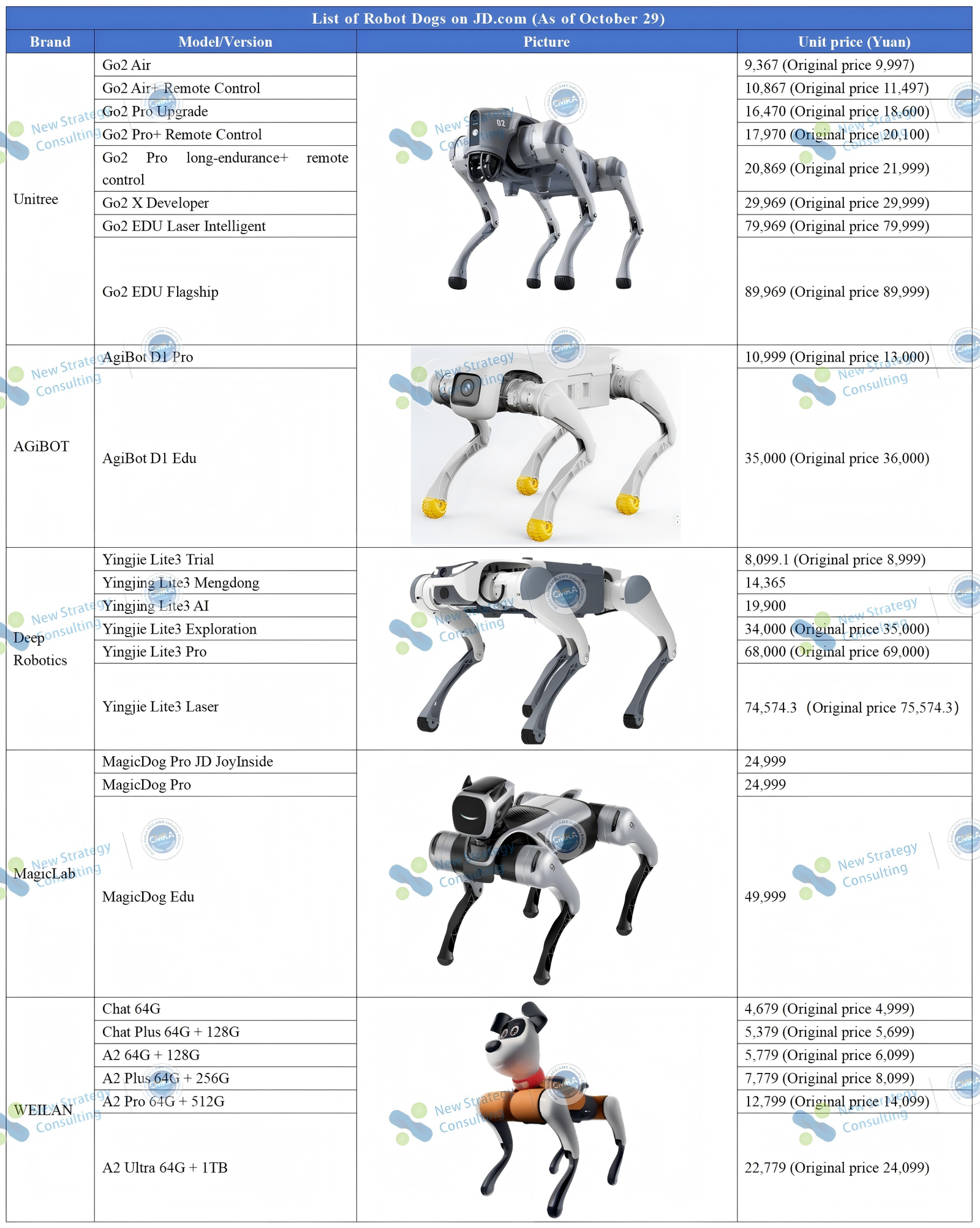With the approach of Double Eleven Shopping Carnival, more and more companies in the robot industry chain are bringing their products to e-commerce platforms and offering attractive prices.
China Mobile Robot Industry Alliance (CMRA) has reviewed the carrier of great concern in the embodied intelligence industry, namely, quadruped robots/robot dogs.
Currently, five quadruped robot brands have established official flagship or directly operated stores on JD.com, namely Unitree, AGiBOT, Deep Robotics, MagicLab, and WEILAN. (excluding desktop and programming robots primarily targeting K12 education)

Compiled from public information. If there are any omissions, please make a correction.
On JD.com, most robot dog products are consumer-oriented with affordable pricing. These devices focus on entertainment, companionship, educational purposes, or lightweight exploration, making them ideal for personal use, university labs, or scientific research.
Special and heavy-duty quadruped robots for B-end are usually sold in a customized way due to their larger size, higher load and more professional applications (such as security inspection, disaster relief, surveying and so on), and are rarely found on e-commerce platforms.
In fact, more than 40 Chinese companies have entered the quadruped robot sector, including manufacturers focusing on industrial, military, or special application scenarios. Most of them have not yet appeared on e-commerce platforms, but are quietly advancing in the stages of technology verification, project collaboration, or industry implementation. (Related post: A comprehensive review of nearly 40 Chinese quadruped robot dog companies!)
Therefore, the products in this inventory more reflect the consumer end trend of the market, and can not be used as a reference for the overall market of quadruped robots.
Price drop: The trend of consumerization is obvious
As can be seen from the chart, the price range of quadruped robots sold by JD.com is wide. The price of entry-level products is generally between 5,000 yuan and 20,000 yuan, while the price of professional or educational versions can reach more than 80,000 yuan.
For instance, Unitree Go2 Air starts at just 9,367 yuan, while its Go2 EDU laser intelligent version costs 79,000 yuan. Deep Robotics Lite3 series offers a clear price range from an 8,000 yuan trial version to a 74,000 yuan laser version.
This tiered pricing structure reflects market strategy of ‘playable for entry, learnable for advancement, and researchable for professionals’ adopted by manufacturers, creating a product chain from consumer experience to scientific research applications. The continuous price drop also indicates that quadruped robots are transitioning from high-precision equipment to consumer-grade smart terminals.
Smart acceleration: From motion control to embodied intelligence
Whereas the past quadruped robots competed mainly on mechanical structure, balance algorithms and motion control, today’s products focus more on AI algorithms, visual navigation and autonomous decision-making.
Both Unitree Go2 Pro long-endurance model and AgiBot D1 Pro are equipped with LiDAR and depth cameras, enabling autonomous obstacle avoidance and path planning. Meanwhile, Deep Robotics Lite3 AI model enhances its control system with advanced intelligent recognition and perception algorithms.
This transformation epitomizes the implementation of the ’embodied intelligence’ concept: robots are no longer just ‘mechanical entities,’ but intelligent agents capable of autonomous behavior through perception, learning, and interaction. The future competition’s focus has shifted from ‘stability in running’ to ‘speed in learning and human understanding.’
Multiple applications: Educational research becomes a breakthrough
In terms of product positioning, multiple brands have launched educational and research versions, such as Unitree Go2 EDU, AgiBot D1 Edu, and Deep Robotics Lite3 Laser. These versions typically provide open SDK interfaces, are compatible with ROS systems, and support algorithm re-development, making them key platforms for universities and research institutes to conduct robotics experiments and AI research.
Meanwhile, MagicLab and WEILAN are launching lightweight robot dogs for family and social content creation, with a focus on “companionship and entertainment,” such as voice interaction, emotion recognition, and motion programming.
This parallel development path of education and entertainment is driving new scenarios for quadruped robots in teaching, creation, companionship, content ecology and other fields.
Conclusion
The mass-market launch of quadruped robots reflects both technological maturity in the industry and growing market interest. These machines have transitioned from laboratory research tools to tangible, interactive smart products, allowing more people to experience the advancements in embodied intelligence firsthand. Looking ahead, as costs decrease, algorithms improve, and application scenarios expand, quadruped robots are poised to redefine boundaries in education, scientific research, security systems, and consumer entertainment. They are becoming one of the most iconic robotic forms in the intelligent era.
——————————————————————————————————————————————————————————————————————————————

The 3rd Ecological Conference for Embodied Intelligence Humanoid Robot Scenario Application 2025 will be held at Hefei Platinum Hanjue Hotel on December 5, 2025. At the same time, Quadruped Robot Scenario Application Development Blue Book 2025 will be released. Stay tuned!





